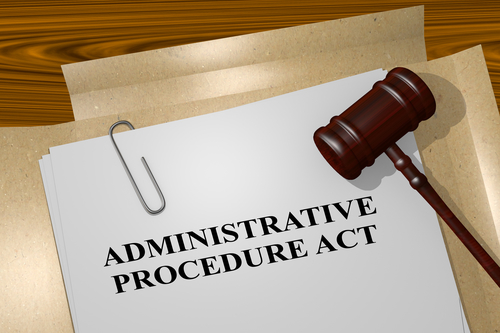“[T]he presumption of reviewability may only be overcome by ‘clear and convincing indications, drawn from specific language, specific legislative history, and inferences of intent drawn from the statutory scheme as a whole, that Congress intended to bar review.” – CAFC
 Last week, the United States Court of Appeals for the Federal Circuit (CAFC) reversed a decision of the U.S. District Court for the Eastern District of Virginia affirming the United States Patent and Trademark Office (USPTO) Director’s vacatur of ex parte reexamination proceedings based on the estoppel provision of the inter partes review (IPR) regime.
Last week, the United States Court of Appeals for the Federal Circuit (CAFC) reversed a decision of the U.S. District Court for the Eastern District of Virginia affirming the United States Patent and Trademark Office (USPTO) Director’s vacatur of ex parte reexamination proceedings based on the estoppel provision of the inter partes review (IPR) regime.
In 2015, Vivint, Inc. sued Alarm.com for infringement of three patents, U.S. Patent Nos. 6,147,601 (the ‘601 patent), 6,462,654 (the ‘654 patent), and 6,535,123 (the ‘123 patent). In response, Alarm.com filed several petitions for IPR, which culminated in three final written decisions in 2017. On review, the CAFC affirmed the decision of the Patent Trial and Appeal Board (PTAB) that Alarm.com had failed to satisfy its burden of proving unpatentable claim 19 of the ‘601 patent, claim 18 of the ‘123 patent and claims 17,18, 22, 25, and 28 of the ‘654 patent.
Ex Parte Reexamination
Despite the CAFC decision, in June 2020, Alarm.com filed three requests for ex parte reexamination of those same claims under 35 U.S.C. §302 and 37 C.F.R. §1.510, raising grounds not previously advanced in the IPRs. The USPTO initially assigned control numbers and filing dates to the requested reexamination proceedings. However, on August 7, 2020, the Director issued three written decisions vacating those proceedings, instead of ruling on the presence of substantial new questions of patentability.
In each decision, the Director noted that the certification Alarm.com submitted under 37 C.F.R. §1.510(b)(6) requires required “a certification by the third party requester that the statutory estoppel provisions of 35 U.S.C. §315(e)(1) do not prohibit the requester from filing an ex parte reexamination request.” The Director also issued a “Clarification of General Policy and Practice” regarding the estoppel precondition of §315(e)(1) that a particular ground of unpatentability asserted against a particular claim be one that was “raised or reasonably could have been raised” in the prior IPR involving the same claim. This General Policy applied when the reexamination requester was the IPR petitioner, or a real party in interest or privy of the IPR petitioner. The Director concluded that Alarm.com reasonably could have raised its reexamination grounds in the IPR proceeding and was therefore estopped under §315(e)(1) from submitting the reexamination requests. This conclusion made the certifications under 37 C.F.R. §1.510 incorrect according to the Director, on that ground each request was vacated. The Director did not conclude that Alarm.com failed to raise a “substantial new question of patentability.”
APA Complaint
On February 12, 2021, Alarm.com filed a complaint under the Administrative Procedure Act (APA) in the Eastern District of Virginia against the PTO and the Director (the government) in his official capacity. Alarm.com argued that the Director’s decisions to vacate the ex parte reexaminations were unlawful final agency actions that should be set aside because the actions or underlying findings were “arbitrary, capricious, an abuse of discretion, or otherwise not in accordance with law, [and] in excess of statutory jurisdiction, authority, or limitations or short of statutory right.” Additionally, Alarm.com requested a permanent injunction to prevent the PTO from applying the General Policy “to grounds presented in any future requests or petitions.
The government motioned to have Alarm.com’s complaint dismissed under Federal Rule of Civil Procedure 12(b)(1) for lack of jurisdiction arguing that the statute in question falls within 5 U.S.C. 701(a)(1), which provides an exception to APA review where “statutes preclude judicial review.” Further, the government asserted that Alarm.com lacked standing to seek the injunction sought. On June 22, 2021, the district court adopted the government’s view and dismissed Alarm.com’s complaint. Alarm.com appealed.
Appeal
On appeal, the government asserted that the overall ex parte reexamination framework precludes judicial review of the Director’s vacatur decisions based upon 35 U.S.C. §315(e)(1) estoppel, making Alarm.com’s challenge to those decisions within the exception to APA review “applicable where statutes preclude judicial review.” The CAFC noted that the government did not argue that judicial review under the APA is unavailable because the agency actions in question are “committed to agency discretion by law.” Nor did the government present a developed argument that APA review is unavailable because “other adequate remedies exist in court.”
Citing Cuozzo, the CAFC recognized that “[w]hen determining whether a statute precludes judicial review, we apply a ‘strong presumption in favor of judicial review.’” Cuozzo Speed Techs., LLC v. Lee, 579 U.S. 261, 273 (2016). However, the CAFC reasoned that a statute need not explicitly state that judicial review is unavailable for preclusion to be found. Again, citing Cuozzo, the CAFC reasoned that “the presumption of reviewability may only be overcome by ‘clear and convincing indications, drawn from specific language, specific legislative history, and inferences of intent drawn from the statutory scheme as a whole, that Congress intended to bar review.” Cuozzo, 579 U.S. at 273.
The CAFC noted the only section of the ex parte statutory scheme that expressly precludes judicial review is §303(c). However, citing Thryv, the CAFC concluded that this preclusion is more limited in scope than the broader preclusion prevision of the IPR scheme and does not extend to the estoppel determinations at issue. Thryv, Inc. v. Click-To-Call Technologies, LP, et al. 140 S.Ct. 1367, 1370 (2020).
The government also argued that the ex parte reexamination statutory scheme clearly demonstrated Congress’s intent to deprive requesters like Alarm.com of all rights to judicial review, including review of the Director’s application of §315(e)(1). The government reasoned that since Congress specific what can be reviewed, who can seek judicial review, where judicial review can be sought and when, that those provisions implicitly preclude the type of review sought in the present case. The CAFC was unpersuaded by this argument. Citing Sackett, the CAFC reasoned that “if the express provision of judicial review in one section of a long and complicated statute were alone enough to overcome the APA’s presumption of reviewability for all final agency action, it would not be much of a presumption at all. Sackett v. EPA, 566 U.S. 120, 129 (2012).
The CAFC also found the government’s legislative history arguments unavailing. Citing Milner, it recognized that such evidence is “too weak to supplant the text and the accompanying presumption of judicial review for the estoppel determination in question.” Cf. Milner v. Dep’t of the Navy, 562 U.S. 562, 572 (2011). Accordingly, the CAFC concluded Alarm.com’s APA challenge to the Director’s vacatur decisions based on estoppel is not precluded, reasoning that “[t]he text, statutory scheme, and legislative history pertaining to ex parte reexamination do not evince a fairly discernable intent to preclude judicial review of these decisions.” For these reasons, the CAFC reversed the district court’s determination that Alarm.com’s 5 U.S.C. §§706(2)(A), (C) challenging the Director’s decisions to vacate the ex parte reexamination proceedings are precluded.

![[IPWatchdog Logo]](https://ipwatchdog.com/wp-content/themes/IPWatchdog%20-%202023/assets/images/temp/logo-small@2x.png)

![[Advertisement]](https://ipwatchdog.com/wp-content/uploads/2024/04/UnitedLex-May-2-2024-sidebar-700x500-1.jpg)
![[Advertisement]](https://ipwatchdog.com/wp-content/uploads/2024/04/Artificial-Intelligence-2024-REPLAY-sidebar-700x500-corrected.jpg)
![[Advertisement]](https://ipwatchdog.com/wp-content/uploads/2024/04/Patent-Litigation-Masters-2024-sidebar-700x500-1.jpg)

![[Advertisement]](https://ipwatchdog.com/wp-content/uploads/2021/12/WEBINAR-336-x-280-px.png)
![[Advertisement]](https://ipwatchdog.com/wp-content/uploads/2021/12/2021-Patent-Practice-on-Demand-recorded-Feb-2021-336-x-280.jpg)
![[Advertisement]](https://ipwatchdog.com/wp-content/uploads/2021/12/Ad-4-The-Invent-Patent-System™.png)






Join the Discussion
No comments yet.